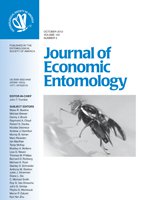Field-based bioassays were used to determine the relative impact of rainfall on the relative toxicity of four insecticides, phosmet, carbaryl, zeta-cypermethrin, or imidacloprid, from different chemical classes on adult Japanese beetles, Popillia japonica Newman, in highbush blueberries, Vaccinium corymbosum L. Bioassays were set up 24 h after spraying occurred and Japanese beetle condition was scored as alive, knockdown or immobile 1, 24, and 48 h after bioassay setup. All insecticides were significantly more toxic than the untreated control and zeta-cypermethrin consistently had the greatest toxic effect against the Japanese beetles. All insecticides experienced a decrease in efficacy after simulated rainfall onto treated blueberry shoots, although the efficacy of zetacypermethrin was the least affected by rainfall. This study will help blueberry growers make informed decisions on when reapplications of insecticides are needed in the field with the aim of improving integrated pest management (IPM).
How to translate text using browser tools
1 October 2012
Rainfastness of Insecticides Used to Control Japanese Beetle in Blueberries
Daniel Hulbert,
Pablo Reeb,
Rufus Isaacs,
Christine Vandervoort,
Susan Erhardt,
John C. Wise
ACCESS THE FULL ARTICLE
It is not available for individual sale.
This article is only available to subscribers.
It is not available for individual sale.
It is not available for individual sale.

Journal of Economic Entomology
Vol. 105 • No. 5
October 2012
Vol. 105 • No. 5
October 2012
Popillia japonica
Precipitation
wash-off




